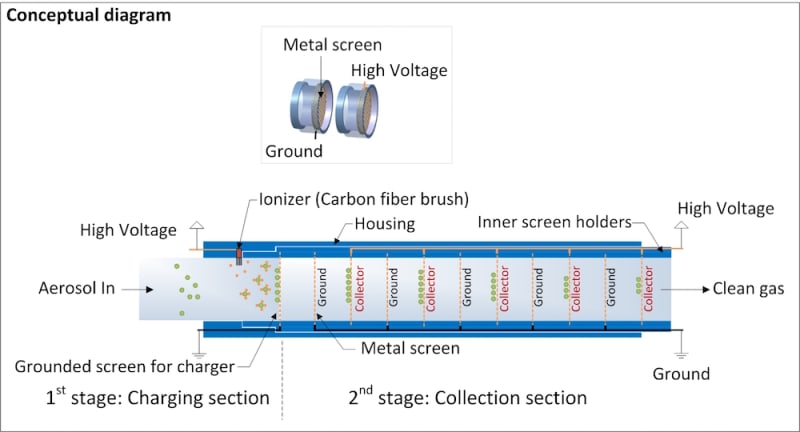To minimize health impacts of air pollution, we designed and developed a novel diesel exhaust control device: the Electrostatic Screen Battery for Emissions Control (ESBEC). The ESBEC is a two-stage electrostatic precipitator with separate charging and collection sections (Fig.1). As the pollutant particles are pulled into the device, they are imparted an electrical charge produced by an ion source such as carbon fiber or tungsten wire (1st stage). The electrically charged pollutant particles then travel into the collector (2nd stage). The collector consists of multiple pairs of conductive screens, in which one screen of each pair is supplied with high voltage and the other is grounded which results in the electrostatic field across the screens. The field removes the particles onto screens and cleans the air. The surface of the collection screens is covered by a superhydrophobic coating thus allowing periodic wash-off (removal) of the collected particles which facilitates the reuse of captured material (black carbon).
The ESBEC features novel design, function, and multiple advantages over existing technologies: 1) open air channel results in low back-pressure and improves mileage, 2) unlike existing technologies, this technology allows removal and reuse of the collected carbon without thermal regeneration, 3) efficiently collects a wide range of airborne particles (99%), including those in the nano-size range (<100 nm), 4) the design results in a low-cost unit.
The ESBEC prototype consists of a collector housing, inner screen holders, closed unit with screens inside, and a charger (Fig. 2). The collector consists of two half-cylinder shells holding the screens. Once the shell is closed, it forms a cylinder of 1.5 inches (or 6 inches) in diameter and is inserted into a housing tube forming an air-tight unit. A carbon fiber brush or tungsten wire (i.e., ion source) is affixed in the housing perpendicular to the air flow and facing the ground screen. The carbon brush contains ~600 - 800 carbon fibers with the diameter of ca. 7 μm or the two tungsten wires (0.003 inches in diameter) make up a crisscross string pattern. The device is manufactured of a heat-tolerant material such as machinable ceramics (e.g., ceramic, or similar). The ESBEC prototype is easy to integrate with other components (e.g., compact DC-to-DC voltage converters). It could be used as one of two options: 1) mounted on the exhaust tailpipe of a truck or bus as a second-stage filter for fine or ultrafine particles or, 2) used to retrofit a truck or bus and be used as a primary filter instead of a conventional diesel particulate filter.
The proposed technology could be deployed not only with diesel-powered automobiles but also with a variety of other mobile and stationary sources of particulate emissions. As such, it has a great potential to be an eco-style or “green” product contributing to significant abatement of harmful air pollutants. This, in turn, will reduce health and environmental impacts of harmful air pollutants.
Like this entry?
-
About the Entrant
- Name:Taewon Han
- Type of entry:teamTeam members:Gediminas Mainelis
- Software used for this entry:Catia, Visio, and Tinkercad for 3D printing
- Patent status:patented





